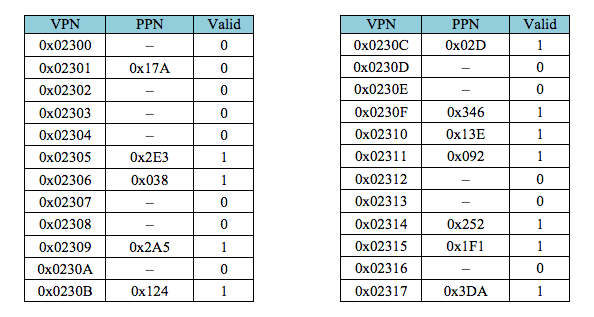Given the following ARM assembly code (sum_nums_asm.s) that sums the numbers from 1 to N, answer the questions below:
mov r1, #0 // sum = 0
mov r3, #1 // i = 1
.loop:
cmp r3, #20
bgt .endloop
add r1, r1, r3
add r3, r3, #1
b .loop
.endloop:
...
Note: Assume the variables of i and sum are stored in registers r3 and r1, respectively.
Questions:
-
What one line would you need to add and/or change in order to sum the following number sequence?
1 4 7 10 13 16 ... -
What two lines (of the original code) would you need to add and/or change in order to compute the factorial of N?
-
What two lines (of the original code) would you need to add and/or change in order to compute the sum of squares from 1 to N?
i.e. 1^2 + 2^2 + 3^2 + 4^2 + 5^2 + ...
= 1 + 4 + 9 + 16 + 25 + ... -
Add a conditional to the loop that checks if the number is even or odd, and negates the value if it's odd. In essence, this will generate the sum:
-1 + 2 - 3 + 4 - 5 + 6 - 7 + 8 - 9 + ...Hint: What one bit in a binary integer representation indicates whether the number is even or odd? And what bit-wise Boolean operation can you use to isolate that number?
Given the following assembly program, some_func.s, determine the equivalent C code corresponding to the procedure some_func(), and fill in the blanks below:
These blanks may include assignment statements, comparisons, and/or other conditional statements (if-then-else). Also, you may not need to use all the blanks.
Many of the blanks will be of the form: result = ...
Note: This file can be downloaded along with a Makefile in hw7_arm_code.zip.
int some_func (int x, int y)
{
int result = ________________________________________;
if (( x ___________________________) || ( ___________________________))
{
_________________________________________________;
_________________________________________________;
_________________________________________________;
_________________________________________________;
_________________________________________________;
}
else
{
_________________________________________________;
_________________________________________________;
_________________________________________________;
_________________________________________________;
_________________________________________________;
}
return result;
}
Create a function in ARM assembly that computes the first n values of the Padovan sequence., where n is the input value to the funciton. The equation for the Padovan sequence is:
P(k) = 1 for k = 0, 1, 2
P(k) = P(k-2) + P(k-3) for k >= 3
Here's the corresponding C code:
int p[100];
void pad_seq (int n)
{
p[0] = 1; // P(0)
p[1] = 1; // P(1)
p[2] = 1; // P(2)
for (k = 3; k < n; i++)
p[k] = p[k-2] + p[k-3]; // P(k)
}
Give the equivalent sequence of assembly instructions for computing the first n values of the Padovan sequence.
Use the file pad_seq_asm.s as the starting point for your code, as it also declares and allocates the space for the p[] array, where you'll save the resulting values. Likewise, the Makefile expects to find this file, and compiles it in combination with pad_main.c to produce the pad_seq_asm executable, which will print out the Padovan values.
The program will need a number of registers and/or variables to manage the values of k,
n, P(k), P(k-2), and P(k-3) for the current
You should turn in a .s file that can be compiled and run on a Pi.
Assume a virtual memory organization with:
- 28-bit virtual addresses
- 20-bit physical addresses
- 10-bit page offsets
Following is a sampling of a portion of the page table for this virtual memory organization:

Given this table, convert the specified virtual address to the corresponding physical address for each of the following virtual addresses. If no valid mapping exists, indicate it's a page fault (i.e. the page is not in physical memory):
- 0x08C54A9
- 0x08C465C
- 0x08C236E
- Finally, determine another valid virtual address (with a different VPN than in parts a - c) and give the corresponding physical address to which it maps.
Note: For part d, you may choose whichever valid VPN and page offset you'd like (though I'd prefer you avoid really simple page offsets like 0x040).
A given computer system has the following cache access times:
- L1 cache: 3 processor cycles
- L2 cache: 10 processor cycles
- L3 cache: 30 processor cycles
- Main memory: 120 processor cycles
-
Program A has the following miss rates:
- L1 cache: 5%
- L2 cache: 30%
- L3 cache: 60%
- Main memory: (assume it always hits in main memory; i.e. miss rate is 0%)
-
What are the hit rates for each level of cache?
-
What is the average memory access time (AMAT) for Program A?
-
Program B has the following hit rates:
- L1 cache: 93%
- L2 cache: 80%
- L3 cache: 60%
- Main memory: (assume it always hits in main memory; i.e. hit rate is 100%)
-
What are the miss rates for each level of cache?
-
What is the average memory access time (AMAT) for Program B?
-
Oftentimes, the program with the lower L1 cache miss rate has the better (lower) average memory access time (AMAT)? Is that true in this case? If not, why?
-
For Program A, what speedup would be achieved if you were able to optimize the program to cut the miss rate of the L2 cache in half (i.e. to 15%) ?
Note: "Speedup" refers to the ratio (fraction) of the original AMAT (with 30% miss rate) to the new AMAT (with 15% miss rate). -
For Program B, if the L1 cycle access time was increased from 3 cycles to 4 cycles (during architecture design), what minimum hit rate would be needed in the L1 cache to achieve the same AMAT?